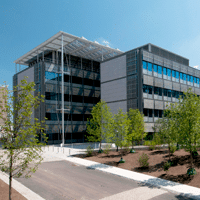When Princeton University moved in 1756 to its current home in Princeton, New Jersey, the entire campus was composed of one building: Nassau Hall. For almost 50 years, it held Princeton’s library, chapel, dorm rooms, classrooms, dining room, and kitchen. But Nassau Hall couldn’t handle Princeton’s entire academic and residential needs forever.
Over time, the campus grew to 180 buildings. By 1990, it encompassed roughly 7 million square feet, and it’s now about 9.5 million square feet, according to director of facilities engineering Tom Nyquist. The growth, however, came with an environmental cost.
The steady expansion significantly increased Princeton’s carbon footprint. To curb its environmental impact, the university created a climate plan in 2007 to conserve natural resources, reduce carbon-dioxide emissions to their 1990 levels by 2020 without the use of offsets (credits that can be purchased to reduce the overall recorded amount of emissions), and cut energy costs by 25–30 percent.

Princeton Data Center: Construction for this state-of-the art facility is pursuing LEED and Energy Star certifications and was managed by Structure Tone, a USGBC member with 165 LEED APs on staff. Photos: Christoper Lillja
Green Building Guidelines
At the start of every large construction project, Princeton holds a sustainability meeting with the design architects, engineers, construction managers, and Facilities Department representatives. Using this integrative design approach, Princeton was able to build an extremely efficient data center that incorporated the latest energy-saving technologies, including cogeneration, water-cooled computer racks, air and water economizers, and highly efficient, water-cooled chillers. Structure Tone handled the data center project and offered advice on capital costs of energy-conservation technology.
Comparing the anticipated energy and maintenance costs for the next 25–30 years to the initial estimates for an energy-conservation feature often makes a strong case for sustainability. “When adding energy-conservation features, we were adding cost, so [the feature] used to get cut,” Nyquist says. “[But] many times, you save so much over the life of the building that you’d be crazy not to put the feature in.”
External consultants also suggest green solutions. Rain gardens were added to the new chemistry building’s site to slow rainwater runoff due to research from Boston-based Nitsch Engineering. “We are tackling new buildings as we add them,” Nyquist says of current projects. “The more efficient they are, the less we have to cut energy elsewhere.”
Although LEED certification isn’t Princeton’s primary goal, it often uses the green-building standards as a general guide. The 250-year-old university also is trying to incorporate sustainability into building renovations, such as its ongoing library restoration. Upgrades include switching to a chilled-beam system that uses water to cool surrounding air more efficiently. “It’s a multiphase project that, in 10 years, could cut building energy use in half,” Nyquist says.

Cogeneration Plant: Princeton added this facility back in 1996, significantly reducing the amount of power it needed to buy.
Revamping Energy Use
Princeton’s plan to reduce emissions will require a $45 million investment through 2017, yet energy-efficiency projects have already resulted in an annual savings of roughly $1.7 million. Nyquist says the university has always tried to reign in energy costs. In 1996, the addition of a cogeneration plant helped reduce the amount of power the university needed to buy. The plant produces electricity and steam efficiently and thereby significantly lowers the campus carbon footprint.
Princeton’s new solar-collector field boasts 16,500 photovoltaic panels, built with the help of Van Note-Harvey Associates, a civil engineer and the project’s environmental consultant. Connected to the main campus’s electrical-power-distribution system, the field is expected to meet 5.5 percent of the total annual need and prevent production of 3,500 metric tons of carbon dioxide per year. The payback? “[This should] help us lower our carbon footprint by six to seven percent,” Nyquist says.
Reduction Results
Since 2008, the university’s emissions have declined by 2.6 percent, and campus energy use increased by just 3.9 percent despite adding more than 560,000 square feet of building space. This year, Princeton plans to add more efficient lighting in at least 12 buildings and outfit more than 40 with energy-efficient, control-system-optimization technology, which Princeton tested in 2011 with positive results.
Yet according to Nyquist, Princeton isn’t the only university undergoing a conservation check. “There’s a general awareness nationwide for many schools to get more energy efficient,” Nyquist says. “A significant number of colleges across the county have hired sustainability directors or managers. And, cutting energy saves money.”

